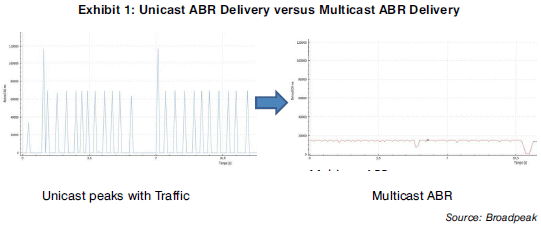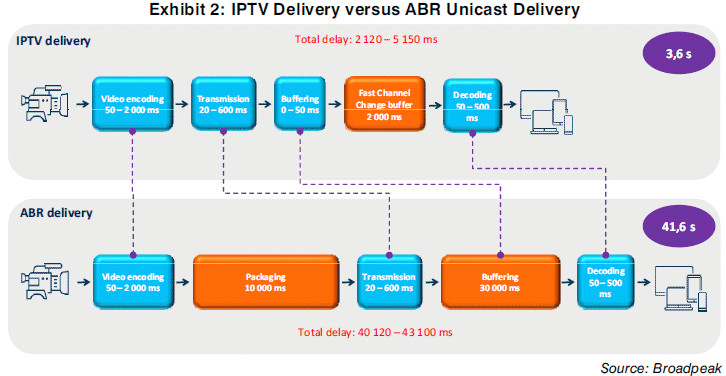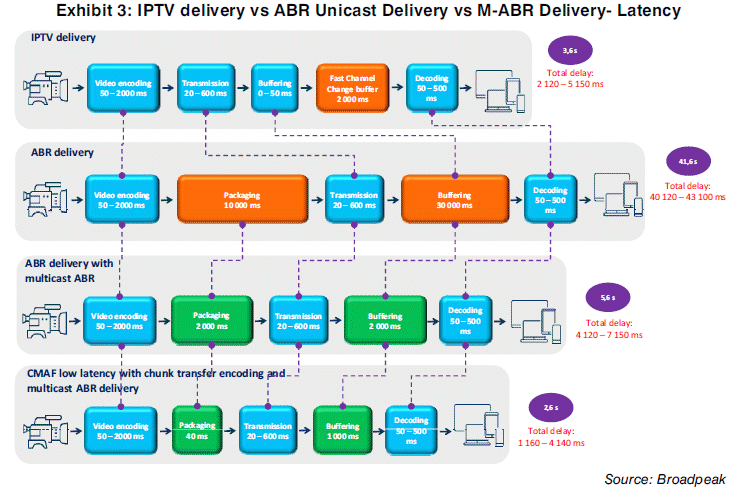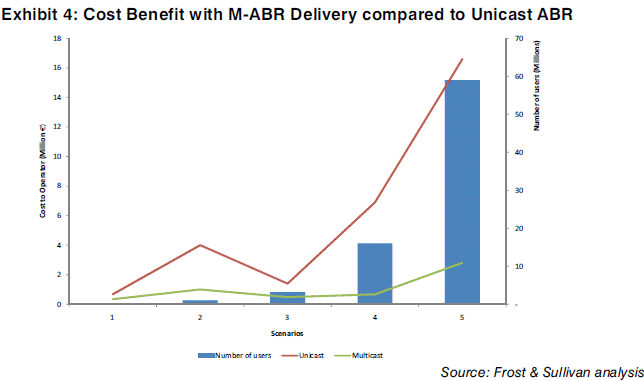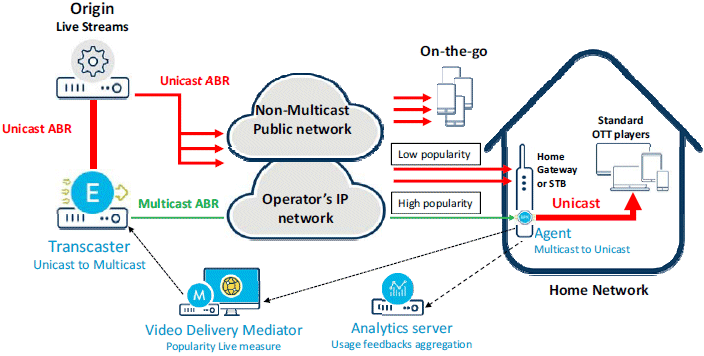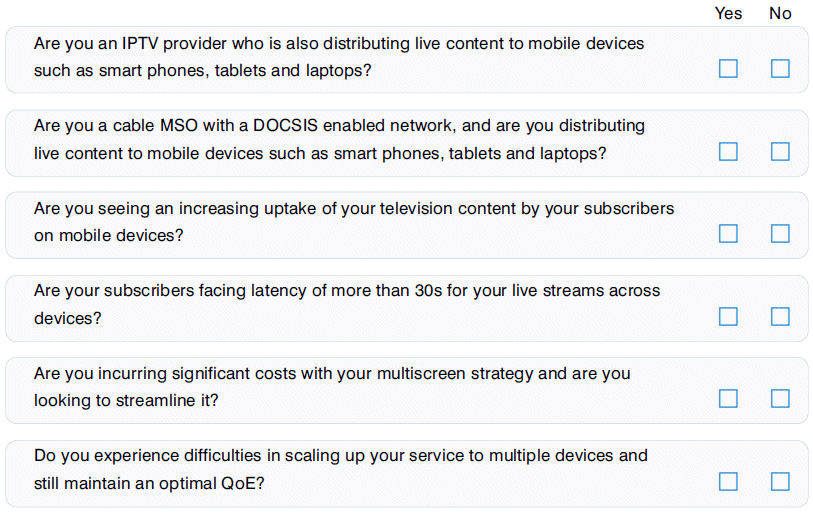By: Vidya S Nath, Sr. Research Director and Swetha R K, Sr. Research Analyst
Click here to download the pdf of this whitepaper, or scroll below to read further
INTRODUCTION
Video viewing habits have changed over the last decade driven by proliferation of connected mobile devices – especially smartphones and tablets. Most of these devices have strong capabilities to support high quality video playback thereby making these screens-of-choice for several users.
One study found that 89% of US video viewers use their smartphones while watching content on TV1. In some instances, these viewers are engaged in television-content related activities on their connected devices. At least 20% of viewers watch more than one program at the same time using a second screen while 19% engage in real time social media discussions about the content they are watching2. Sometimes, the second screen is a natural substitute or alternative for the TV set. For instance, a viewer could start watching a video on the living- room TV set and then continue watching it on their smartphone or tablet in bed. Regardless of the use case, multiscreen video is the new normal for consumers and they expect the same or similar quality of experience (QoE) across all platforms.
For Pay TV operators worldwide, multiscreen distribution is a must-have strategy, and many leading operators, including SFR and Orange in France, PCCW in Hong Kong, Ziggo in Netherlands, Verizon and Comcast in the US, among many others already enable it. But several find it challenging, as it requires a simulcast of TV services to not just a television set powered by a set top box (STB), but also to multiple connected devices that differ in brands, form factors, operating systems, and resolutions.
Content distributors deliver video content over broadband to multiscreen devices using HTTP adaptive bit rate streaming; however HTTP was not built for video delivery, resulting in significant cost and operational hassle for many Pay TV providers. The most commonly used streaming protocols include HLS and DASH, but live multiscreen delivery continues to be plagued by latency issues. In order to address these challenges, operators, especially IPTV service providers and cable MSOs, are considering multicast adaptive bit rate (M-ABR) technology for multiscreen video delivery.
This whitepaper elaborates upon the challenges faced by Pay TV operators that can be addressed by M-ABR.
A PAY TV MULTISCREEN DILEMMA MANAGING TRAFFIC FROM MOBILE DEVICES
The pay TV market worldwide has become highly mature and is universally threatened by a gradually growing number of ‘cord shavers’ and ‘cord cutters’- subscribers who are either reducing the time and money on pay TV or canceling their subscription to switch to other alternatives (such as over-the-top video services). “Frost & Sullivan estimates that the number of pay TV households will grow from nearly 900 million in 2017 to over 1.5 billion at a CAGR of 6.2% , and revenue could grow at a CAGR of 1.3% from $199 billion to $207 billion. Yet, predictions are becoming increasingly fluid and are dependent on how viewership habits will trend. Almost 60%3 of video viewing today happens over mobile devices and has been increasing at double digit growth rates over the last two years. It is forecast that the number of smart phone users is expected to increase at a CAGR of 25% from 2 billion in 2017 to 3.9 billion by 2020.
Consequently, operators have no choice but to deliver content to where the audience is.
Unfortunately, live streaming to mobile devices cannot be achieved with the same speed as TV. Linear TV provides for a one-to-many scenario, and there is little impact of ‘traffic’ on the headend. Bandwidth requirements for linear TV are driven by how many channels an operator has to carry and not so much by how many viewers will access the channels.
But with HTTP adaptive bitrate video delivery to mobile devices, connected TVs and Android set-top boxes, the pressure of bandwidth usage has shifted towards the delivery network. Higher the demand from individual viewers from connected devices for each channel, the higher the traffic, resulting in spikes in the network usage. Traffic is unpredictable and can fluctuate dramatically based on peak times for television viewing, such as prime time, or live events, especially sports.
Most operators handling HTTP video delivery are not prepared for this, thereby resulting in significant cost of content delivery through unicast streams to each and every connected device. These costs are compounded for HD and 4K streams, not to mention the difficulty in keeping bandwidth constant with minimal packet loss.
Multicast ABR or M-ABR leverages the bandwidth efficiencies of IP multicast over the operator network, and combines it with adaptive bit rate streaming to enable the operator to stream live content only once in its network. The content is then deployed to the home network via a set- top box or home gateway, which then unicasts the content to the connected devices.
M-ABR enables an operator to smoothen the traffic demands for any channel, thereby rationalizing network bandwidth usage, while improving the quality of service.
LIVE TV STREAMING – HOW CAN LATENCY BE REDUCED?
It is expected that consumption of live video would grow 15 times by 2021, constituting up to 13% of Internet video traffic4. One live TV genre that will drive this trend is sports. As more premium sports content becomes available on a handset, it is expected that mobile video streaming could exceed 70%1 of all video viewing.
For Pay TV operators, it is extremely important to get sports streaming right as it guarantees a large base of loyal subscribers. This means having to chase the highest benchmarks for quality of service and quality of experience, which once established can be replicated for all other genres if needed. Popular live sports events intensify viewership traffic as well as viewer sensitivity towards latency and quality of video streaming (with little or no instances of buffering, freezing, or other glitches). Subscribers want no or minimal difference between what is telecast on linear TV and what they get to view on mobile devices.
The key to non-latency lies in how to optimize the workflow tasks that make up the video delivery process- video encoding, packaging, transmission, decoding, encryption, and others. As seen in the illustrated Exhibit 3, unicast delivery can cause a 40-43 second delay compared to a 2-5 second delay in IPTV. There is little buffering required in the latter as the networks are provisioned for content delivery to set top boxes.
On the other hand, unicast delivery is delayed significantly by 40-43 seconds because of packaging as well as buffering in the device to ensure video streaming continuously.
A number of HTTP streaming protocols evolved over time to enable video delivery to connected devices, however, many have been gradually replaced and the dominant ones in usage today are HLS and MPEG-DASH. The challenge is that not all devices are compatible with both formats, and while over the last couple of years, CMAF emerged as unifying format, it is yet to become a universal standard. CMAF comes with a low latency profile that brings latency improvement by allowing the segments of video to be processed on the fly at each step even if they are not completely received. Packaging is therefore a key step for HTTP video delivery. The process takes the transcoded video and applies appropriate streaming format based on the device that requests for it.
After packaging, HTTP video delivery includes buffering- which is necessary to handle bursts of IP packets that in a standard unicast network are delivered in a best effort mode. If the buffer size is too small for the type of network that is used for content delivery the playout will be interrupted whenever the rebuffering will occur often causing service interruption. Hence the quality of video depends on the network speed, the number of concurrent viewers, quality of the embedded device video player, and the resolution of the video to be streamed. With iOS devices, each chunk can last 6-10 seconds and usually 3 chunks are buffered in the player, causing up to 30 second delay from live transmission. Some Android video players require 5 chunks of 2s each.
M-ABR can alleviate these concerns. With M-ABR, an operator can bring the traffic from an unmanaged network to a managed multicast network, reducing the size and number of chunks to buffer for a smooth playout, and drive low latency packaging, bringing it down from 40 seconds to 6 seconds, thereby driving significant improvement in QoE metrics. With its low latency flavor, CMAF with Chunk Transfer Encoding (CTE) allows to further reduce latency and brings it down to 2 to 3 seconds.
SAVING COSTS ON VIDEO DELIVERY ON MANAGED NETWORKS
Unlike traditional unicast systems where cost to the operator goes up as the number of users or the amount of peak traffic rises, a multicast system gives more savings in the same scenario. For instance, if one million concurrent viewers are watching a live event using an operator’s network at 2 Mbps, the content has to be streamed to every user, making the load at the edge 2 Tbps. On the other hand, with multicast, the load at the edge would just be few Mbps since the content is carried only once over the entire network, thereby making it more efficient.
While there is an upfront additional infrastructure investment for an M-ABR server and software license apart from the unicast infrastructure, the ROI is huge, especially when the service scales up. This gives clear cost savings in the range of 50% – 90%, compared to unicast, depending on the specific operator requirements.
The chart below compares the cost dynamics in unicast and multicast ABR systems based on the number of users across different scenarios.
As can be seen in the chart, the cost of unicast ABR is correlated to the number of concurrent users, and eventually to the bandwidth consumption, stream bitrates, pixel quality of content, and number of streaming formats (HLS/DASH). With the demand for bandwidth intensive 4K/UHD/8K content going up phenomenally, costs of premium live streaming will certainly go up, thus strengthening the case for M-ABR.
Another alternative explored by operators is to use CDNaaS (CDN as a service) and add multiple Points of Presence (PoPs) with more servers to support more and more concurrent users, but it is not economical. A single CDN can typically support up to one million concurrent users, beyond which QoE metrics drop. The total cost of ownership for an IPTV operator in using multicast ABR instead of CDN-as-a-Service (CDNaaS) can reduce costs significantly, especially when the service scales up.
While multicast ABR is a cost-effective solution for an operator to handle peaks in live multiscreen IPTV distribution, it should also be transparent and compatible with the consumer device without requiring huge modifications. A solution such as that of Broadpeak’s nanoCDN™ boosts the benefits of the operator’s home network by serving as a cost-effective extension to manage peak loads.
SOLUTION BRIEF: BROADPEAK’S NANOCDN
Broadpeak’s nanoCDN™ technology empowers cable and telecom operators to deliver live OTT content in a scalable way to millions of users, leveraging their control over home network components – set-top-boxes or home gateways.
The Video Delivery Mediator constantly measures the popularity of each channel and automatically allocates to the nanoCDN the requests for the most popular ones. For these channels, a transcaster in the head-end converts the unicast streams into multicast, allowing the operator to serve millions of viewers with a single stream. In addition, it creates the conditions for resolving typical quality of experience issues related to http streaming such as high latency or recurrent buffering. An agent installed in the CPE receives the multicast stream and converts it back to unicast for delivery to individual devices across the residential environment. The compatibility with DRM and the Adaptive Bitrate policy remain unchanged.
At the end of each user’s session, the nanoCDN feeds back the system with information allowing the Video Delivery Mediator to update dynamically the channels popularity. The multicast resources can thus be reallocated accordingly.
CASE STUDY
The Problem: A major telecom operator in Europe was looking for solutions to reduce the cost of bandwidth usage for its newly launched TV DSL service—which included distributing 20 channels to 200,000 TV subscribers and 3 million mobile subscribers, across a large network covering 7 different time zones. Having to scale up its service to a large and widely distributed subscriber base ended up in escalating costs of content delivery, while shrinking its bottom line.
The Solution: Broadpeak implemented the nanoCDN solution to make the service more scalable for the operator without significant overhead. Deploying the nanoCDN technology has helped the operator to maintain a fixed live video delivery cost, thereby saving 90% of what it would have otherwise spent on content delivery for traditional http distribution. The nanoCDN agent was embedded in two different Android based home gateways. This project including the integration with the full ecosystem (service platform, middleware, and, headend) was executed in less than 6 months.
THE BOTTOM LINE
Multiscreen video delivery is the new age reality, but still highly challenging for operators in several parts of the world. Legacy IPTV and cable networks are capable of only delivering MPEG Transport Streams to television, and hence to distribute video to connected devices such as smartphones, tablets, PCs, connected TVs, and Android STBs, operators typically need to use http delivery. This not only adds to operational cost but also impairs QoE metrics such as scalability and latency, especially during live streaming of events and sports. Multicast ABR offers a suitable fix by combining the benefits of adaptive bit rate delivery (in terms of functionality and device reach) with multicast delivery while keeping overall costs rational.
CALL TO ACTION

Frost & Sullivan, the Growth Partnership Company, works in collaboration with clients to leverage visionary innovation that ddresses the global challenges and related growth opportunities that will make orbreak today’s market participants. For more than 50 years, we have been developing growth strategies for the Global 1000, emerging businesses, the public sector and the investment community. Is your organization prepared for the next profound wave of industry convergence, disruptive technologies, increasingcompetitive intensity, Mega Trends, breakthrough best practices, changing customer dynamics and emerging economies?
For information regarding Frost & Sullivan’s whitepaper, please write to:
Vidya S Nath
Director, Digital Media, Frost & Sullivan
P: 91 44 6681 4001 | M: 91 99401 94838 | E: vnath@frost.com
1 Smartphone use while watching TV – US, Statista, 2017
2 Ericsson Consumer Lab Survey, 2016
3 Ooyala Global Video Index, Q4 2017
4 Cisco VNI, 2016 – 2021
